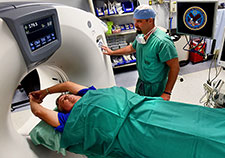Office of Research & Development |
 |


VA’s hospital rating system addresses hospital structure, inpatient outcomes, outpatient outcomes, and patient satisfaction. (Photo for illustrative purposes only. ©iStock/monkeybusinessimages)
December 3, 2019
By Erica Sprey
VA Research Communications
"Am I happy with the care VA provides, or would I get better treatment somewhere else on the outside?"
A recent study, published online in Population Health Management, scrutinized the accuracy and validity of four different health care rating systems. The researchers found that VA does a better job of measuring hospital performance than other government and private-sector rating systems.
Researchers from the James J. Peters VA Medical Center in the Bronx and the Icahn School of Medicine at Mt. Sinai in New York examined patient outcomes reported by U.S. News' America's Best Hospitals, Truven Health Analytics, the Centers for Medicare and Medicaid Services' Hospital Compare, and VA.
The results of these reports are used by consumers and other parties for a variety of reasons.
For example, patients needing a knee replacement could consult the data to compare costs or find out what the infection rates are at different facilities. The reports also track patient satisfaction.
Some of the reports are used to rank hospitals from worst to best—in the case of Hospital Compare and VA SAIL, hospitals are assigned a ranking from 1 to 5 stars, where 5 is the best score.

VA in new research agreement with National Institute of Allergy and Infectious Diseases

Spreading innovation across VA health care

Study raises new warnings about frail surgery patients

Smokers hazy on actual benefits of lung cancer screenings
The researchers wanted to find out how transparent this reporting was, meaning: Does each system report on all patient metrics that might be useful and relevant for consumers?
The team used publicly available data to compare the four rating systems. They identified a set of common measures reported in Hospital Compare and VA SAIL, the two most comprehensive systems, that they could use to compare reporting across all four systems. These metrics describe hospital structure, inpatient outcomes, outpatient outcomes, and patient satisfaction.
When the researchers looked at reporting on these metrics across all the systems, however, the outcomes were uneven. They found significant discrepancies in reporting for non-VA hospitals. Many of these hospitals did not report on all patient metrics—important data that show, for example, the numbers of deaths from heart attacks. In a comparison of the four rating systems, for instance, VA SAIL was the only rating system that reported on RN turnover rate and patient access to care.
In addition, Hospital Compare excluded data from 1,099 hospitals that were too small to provide robust data.
Furthermore, those measures that were reported were not always equivalent.
For instance, while American's Best Hospitals reported on inpatient mortality rates—that is, deaths of patients while they are still in the hospital—it does not report on 30-day mortality rates or 30-day readmission rates like the other three rating systems. Both 30-day metrics are important measures that illustrate how well a hospital has cared for its patients.
In contrast, VA reporting was 100 percent. VA reported data for every measure assessed in the study from each of the 146 hospitals in its nationwide system that provided acute inpatient medical/surgical care.
All these VA hospitals reported on deaths from heart attack, for instance. In contrast, 1,150 non-VA hospitals represented in Hospital Compare data did not report on that measure.
Lead study author Dr. Erik Langhoff says the results of the study are timely because the MISSION Act was passed into law in 2018. The law, which builds on the previous Veterans Choice Program, expands the ability of Veterans, in certain circumstances, to seek community care outside the VA health care system and have it paid for by VA.
The intent of the law is to give Veterans greater choice, and to make sure that they have timely access to appropriate, quality health care—whether that care is provided within VA or in the community.
Langhoff says providing insight into how rating systems differ and showing how VA surpasses the others in terms of transparency and thoroughness, may help Veterans make decisions on where to seek care.
"There will be enhanced opportunities for Veterans to seek care outside VA, in their communities," notes Langhoff. “This will allow them to ask, ‘Am I happy with the care VA provides, or would I get better treatment somewhere else on the outside?’”
Along with attesting to VA’s reporting transparency, the new study results also provide evidence as to the quality of VA’s care. When looking at the quality of patient care, Langhoff and his colleagues found that VA provided a level of care that was equal to, or in some cases better than, patient care reported through Hospital Compare.
That information is in line with previous studies by RAND and Dartmouth and VA researchers that found VA generally delivers higher-quality care than most non-VA health care providers and hospitals.
VA Research Currents archives || Sign up for VA Research updates